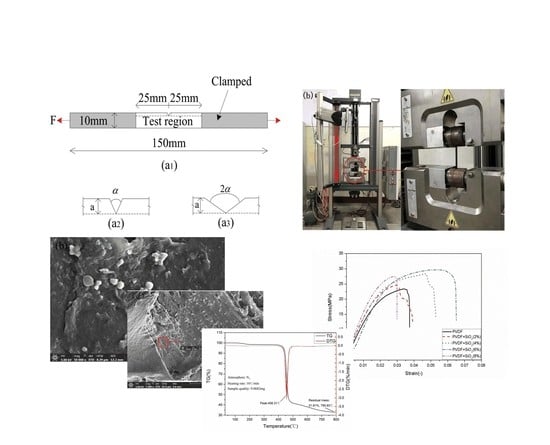Comprehensive Analysis of Mechanical Properties of CB/SiO2/PVDF Composites
Abstract
:1. Introduction
2. Materials and Methods
2.1. Materials
2.2. Preparation of Composite Films
2.3. Material Characterization
3. Results
3.1. Effect of Notch Geometry on Stress–Strain Relationship of SiO2/PVDF
3.2. Effect of CB Content on Mechanical Properties of CB/PVDF
3.2.1. Tensile Properties of CB/PVDF Composites
3.2.2. SEM and EDS Analysis of CB/PVDF Composites
3.3. Effect of CB/SiO2 on Mechanical Properties of Composites
3.3.1. Effect of CB and SiO2 Contents on Tensile Properties of Composites
3.3.2. SEM and EDS Analysis of CB/SiO2/PVDF Composites
3.3.3. XRD Analysis of CB/SiO2/PVDF Composites
3.3.4. TG Analysis of CB/SiO2/PVDF Composites
4. Conclusions
Author Contributions
Funding
Acknowledgments
Conflicts of Interest
References
- Zhang, Y.; Ye, L.; Zhang, B. Characteristics and performance of PVDF membrane prepared by using NaCl coagulation bath: Relationship between membrane polymorphous structure and organic fouling. J. Membr. Sci. 2019, 579, 22–32. [Google Scholar] [CrossRef]
- Cai, J.; Hu, N.; Wu, L. Preparing carbon black/graphene/PVDF-HFP hybrid composite films of high piezoelectricity for energy harvesting technology. Compos. Part A Appl. Sci. Manuf. 2019, 121, 223–231. [Google Scholar] [CrossRef]
- Wang, Z.Q.; Kong, F.Y.; Chang, M.Z. A comprehensive investigation of particle effect on the mechanical property, hydrophobicity and permeability of polymer composite membranes based on a chain model. J. Membr. Sci. 2019, 590, 117302. [Google Scholar] [CrossRef]
- Xu, H.; Zeng, Z.; Wu, Z. Broadband dynamic responses of flexible carbon black/poly (vinylidene fluoride) nanocomposites: A sensitivity study. Compos. Sci. Technol. 2017, 149, 246–253. [Google Scholar] [CrossRef]
- Wu, L.; Yuan, W.; Hu, N. Improved piezoelectricity of PVDF-HFP/carbon black composite films. J. Phys. D Appl. Phys. 2014, 47, 135302. [Google Scholar] [CrossRef]
- Lazarraga, M.G.; Mandal, S.; Ibanez, J. LiMn2O4-based composites processed by a chemical-route: Microstructural, electrical, electrochemical, and mechanical characterization. J. Pow. Sour. 2003, 115, 315–322. [Google Scholar] [CrossRef]
- Fuertes, A.B.; Pico, F.; Rojo, J.M. Influence of pore structure on electric double-layer capacitance of template mesoporous carbons. J. Pow. Sour. 2004, 133, 329–336. [Google Scholar] [CrossRef]
- Ha, S.; Ramani, V.K.; Lu, W. Optimization of inactive material content in lithium iron phosphate electrodes for high power applications. Electrochim. Acta 2016, 191, 173–182. [Google Scholar] [CrossRef]
- Xing, C.; Wang, Y.; Huang, X. Poly (vinylidene fluoride) nanocomposites with simultaneous organic nanodomains and inorganic nanoparticles. Macromolecules 2016, 49, 1026–1035. [Google Scholar] [CrossRef]
- Zhu, J.; Shen, J.; Guo, S. Confined distribution of conductive particles in polyvinylidene fluoride-based multilayered dielectrics: Toward high permittivity and breakdown strength. Carbon 2015, 84, 355–364. [Google Scholar] [CrossRef]
- Wu, G.; Miura, T.; Asai, S. Carbon black-loading induced phase fluctuations in PVDF/PMMA miscible blends: Dynamic percolation measurements. Polymer 2001, 42, 3271–3279. [Google Scholar] [CrossRef]
- Li, L.; Zhang, M.; Ruan, W. Studies on synergistic effect of CNT and CB nanoparticles on PVDF. Polym. Compos. 2015, 36, 2248–2254. [Google Scholar] [CrossRef]
- Brostow, W.; Keselman, M.; Mironi-Harpaz, I. Effects of carbon black on tribology of blends of poly (vinylidene fluoride) with irradiated and non-irradiated ultrahigh molecular weight polyethylene. Polymer 2005, 46, 5058–5064. [Google Scholar] [CrossRef] [Green Version]
- Antunes, R.A.; De Oliveira, M.C.L.; Ett, G. Investigation on the corrosion resistance of carbon black–graphite-poly (vinylidene fluoride) composite bipolar plates for polymer electrolyte membrane fuel cells. Int. J. Hydrog. Energy 2011, 36, 12474–12485. [Google Scholar] [CrossRef]
- Thomas, R.; Guillen-Burrieza, E.; Arafat, H.A. Pore structure control of PVDF membranes using a 2-stage coagulation bath phase inversion process for application in membrane distillation (MD). J. Membr. Sci. 2014, 452, 470–480. [Google Scholar] [CrossRef]
- Sardarabadi, H.; Mousavi, S.M.; Saljoughi, E. Removal of 2-propanol from water by pervaporation using poly (vinylidene fluoride) membrane filled with carbon black. Appl. Surf. Sci. 2016, 368, 277–287. [Google Scholar] [CrossRef]
- Laiarinandrasana, L.; Besson, J.; Lafarge, M. Temperature dependent mechanical behaviour of PVDF: Experiments and numerical modelling. Int. J. Plast. 2009, 25, 1301–1324. [Google Scholar] [CrossRef]
- Ke, K.; Bao, R.Y.; Liu, X.Q. Insight into the nucleating and reinforcing efficiencies of carbon nanofillers in poly (vinylidene fluoride): A comparison between carbon nanotubes and carbon black. J. Membr. Sci. 2013, 48, 8509–8519. [Google Scholar] [CrossRef]
- Haddadi, S.A.; Ramazani, S.A.; Talebi, S. Investigation of the Effect of Nanosilica on Rheological, Thermal, Mechanical, Structural, and Piezoelectric Properties of Poly (vinylidene fluoride) Nanofibers Fabricated Using an Electrospinning Technique. Ind. Eng. Chem. Res. 2017, 56, 12596–12607. [Google Scholar] [CrossRef]
- Kong, F.Y.; Chang, M.Z.; Wang, Z.Q. Investigation of the effect of nanosilica on mechanical, structural, and fracture toughness of polyvinylidene fluoride films. Mater. Res. Express 2019, 6, 105369. [Google Scholar] [CrossRef]
- Ke, K.; Pötschke, P.; Wiegand, N.L. Tuning the network structure in poly (vinylidene fluoride)/carbon nanotube nanocomposites using carbon black: Toward improvements of conductivity and piezoresistive sensitivity. ACS Appl. Mater. Interfaces 2016, 8, 14190–14199. [Google Scholar] [CrossRef]
- Huang, K.; Ning, H.; Hu, N. Synergistic effect of CB and MWCNT on the strain-induced DC and AC electrical properties of PVDF-HFP composites. Carbon 2019, 144, 509–518. [Google Scholar] [CrossRef]
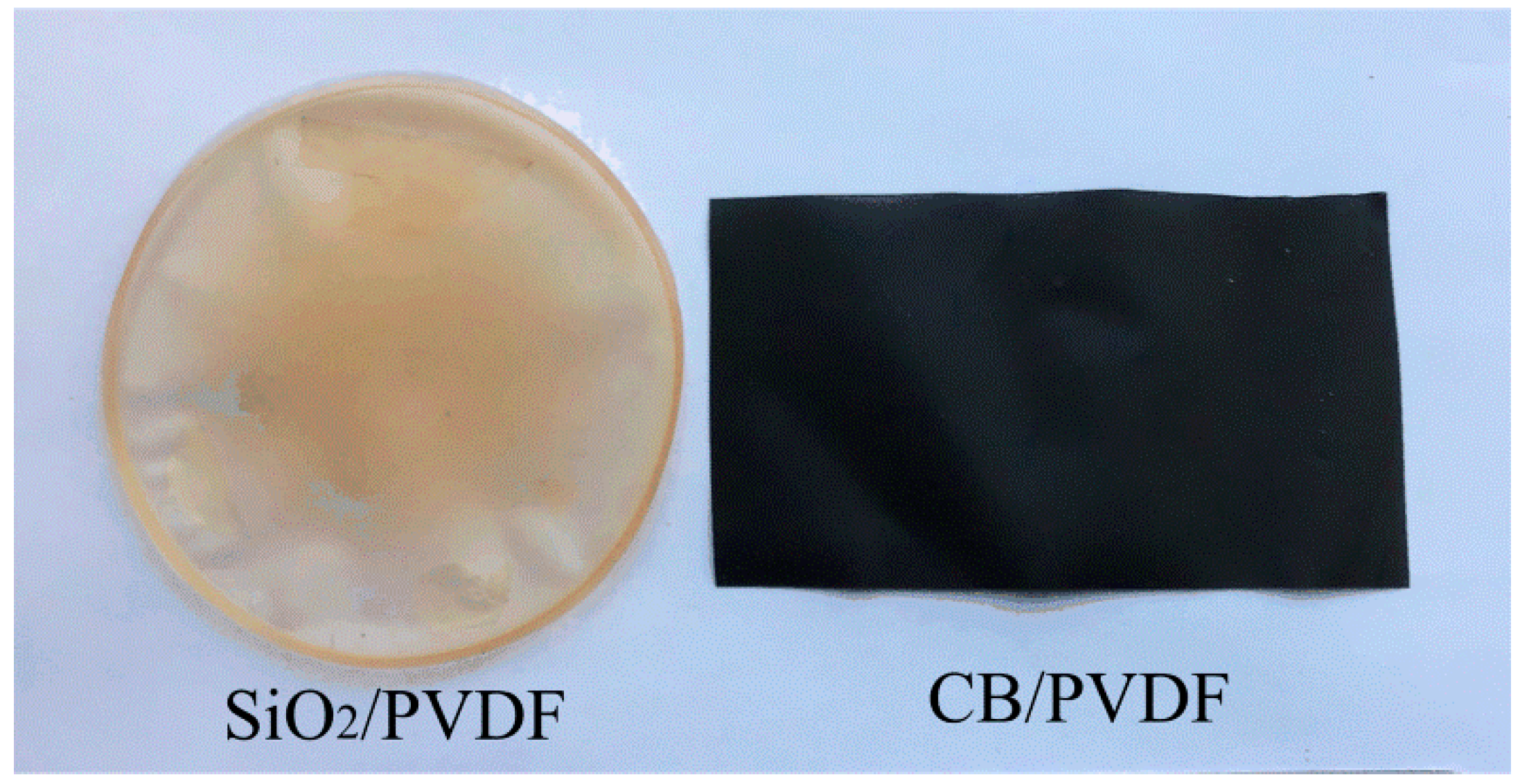

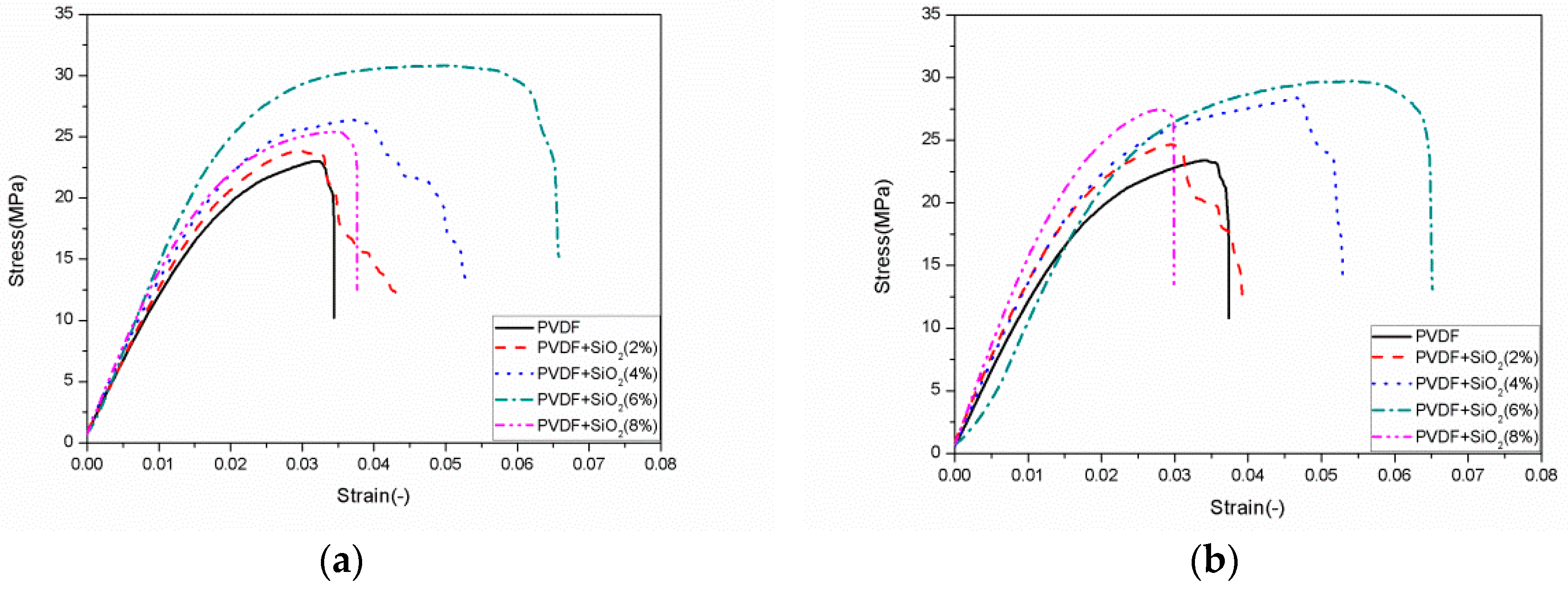
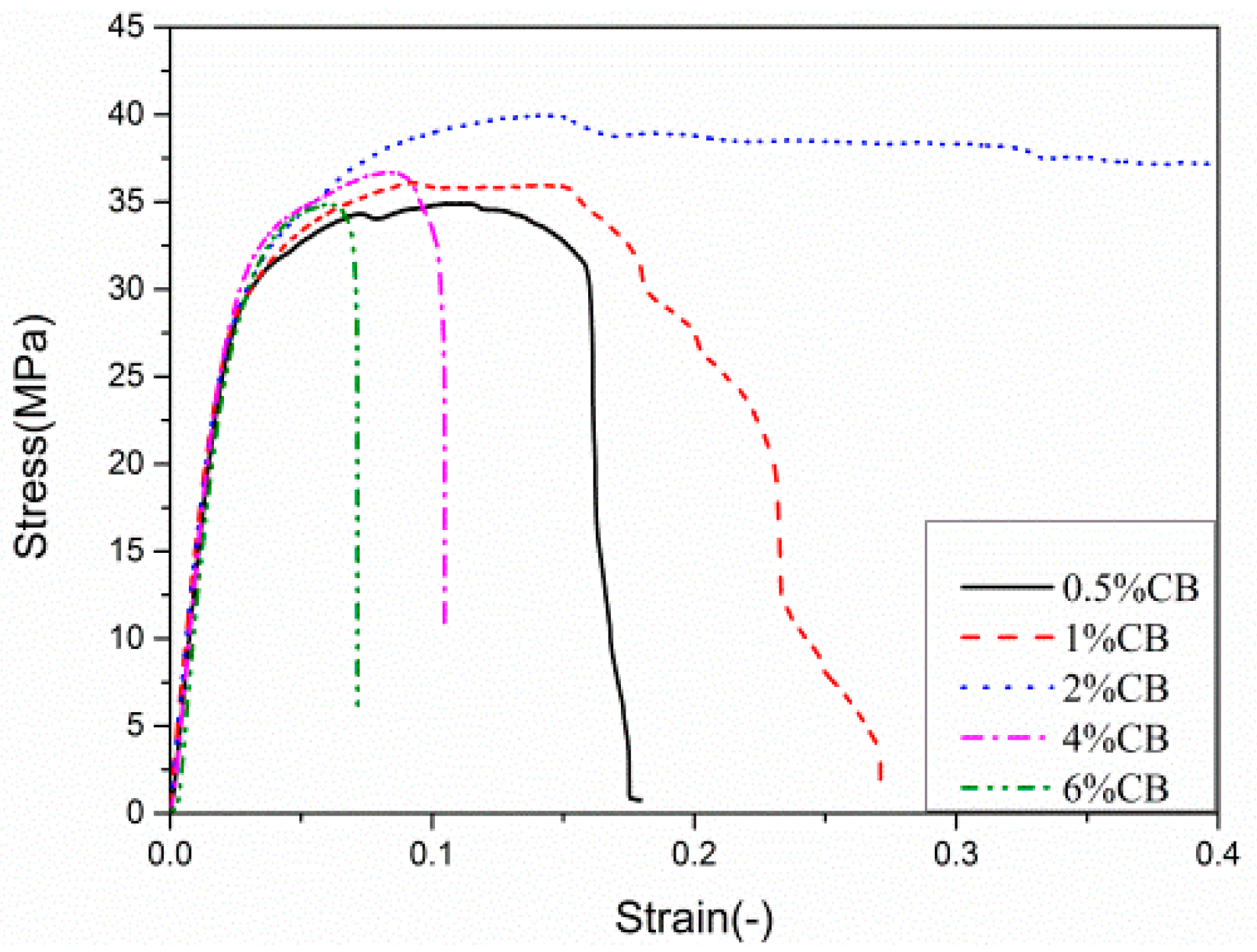
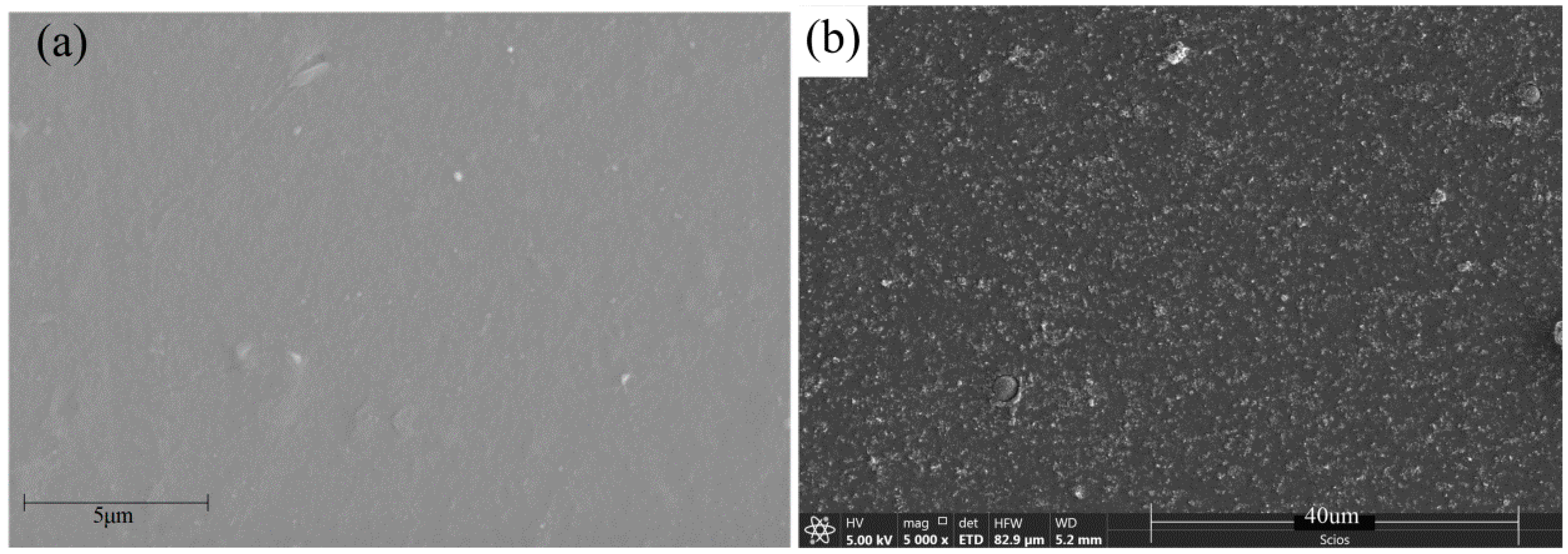
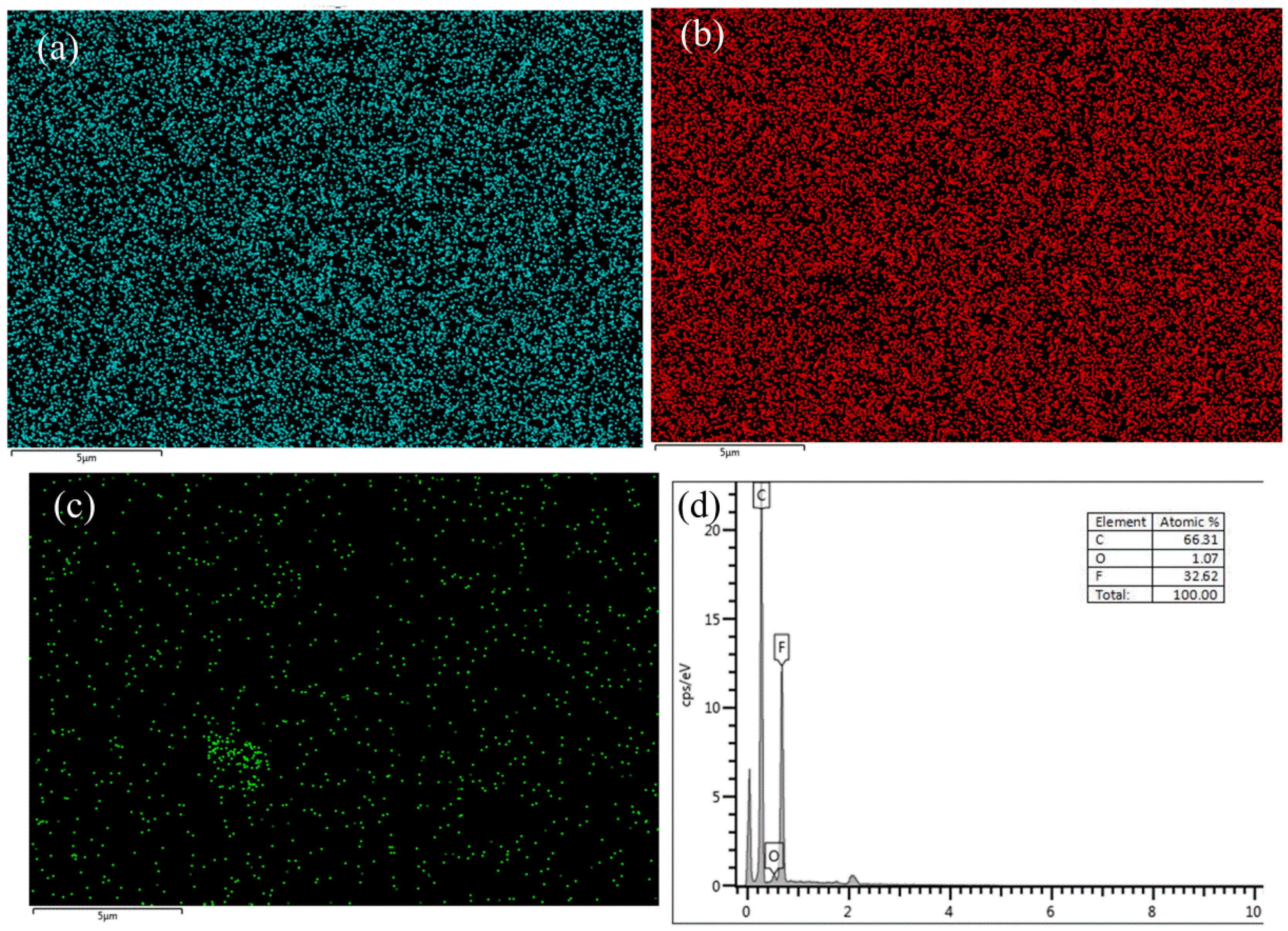
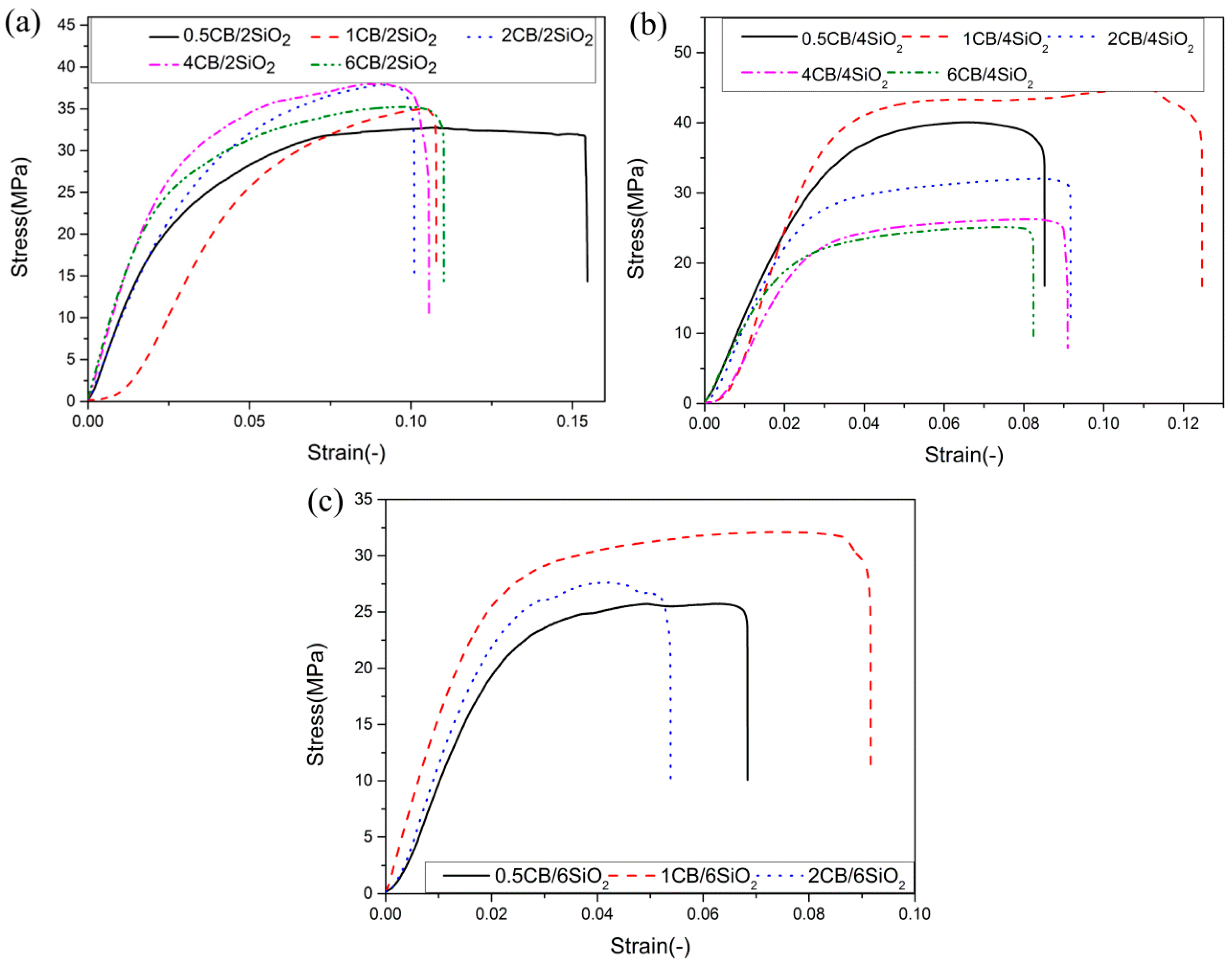
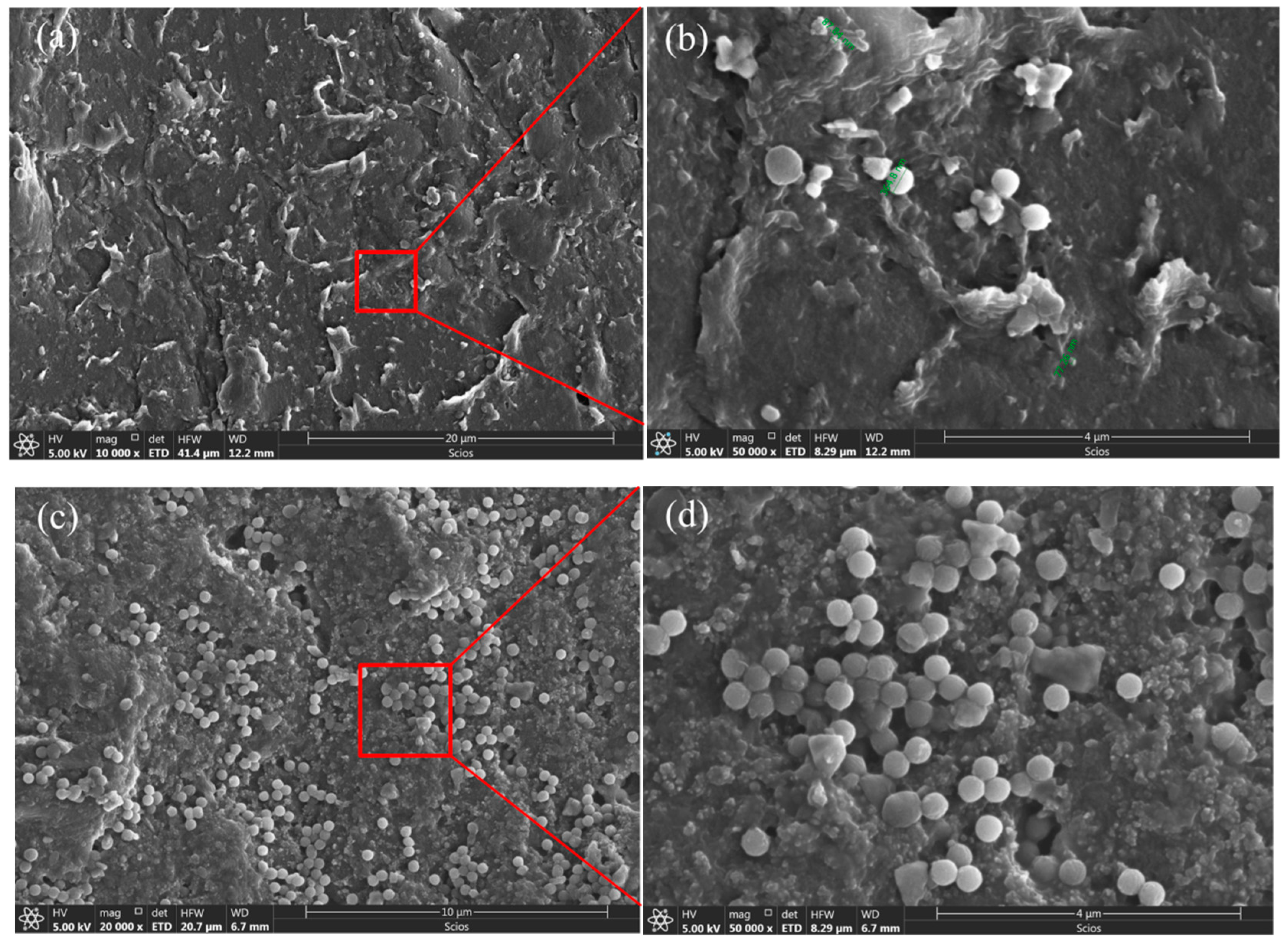
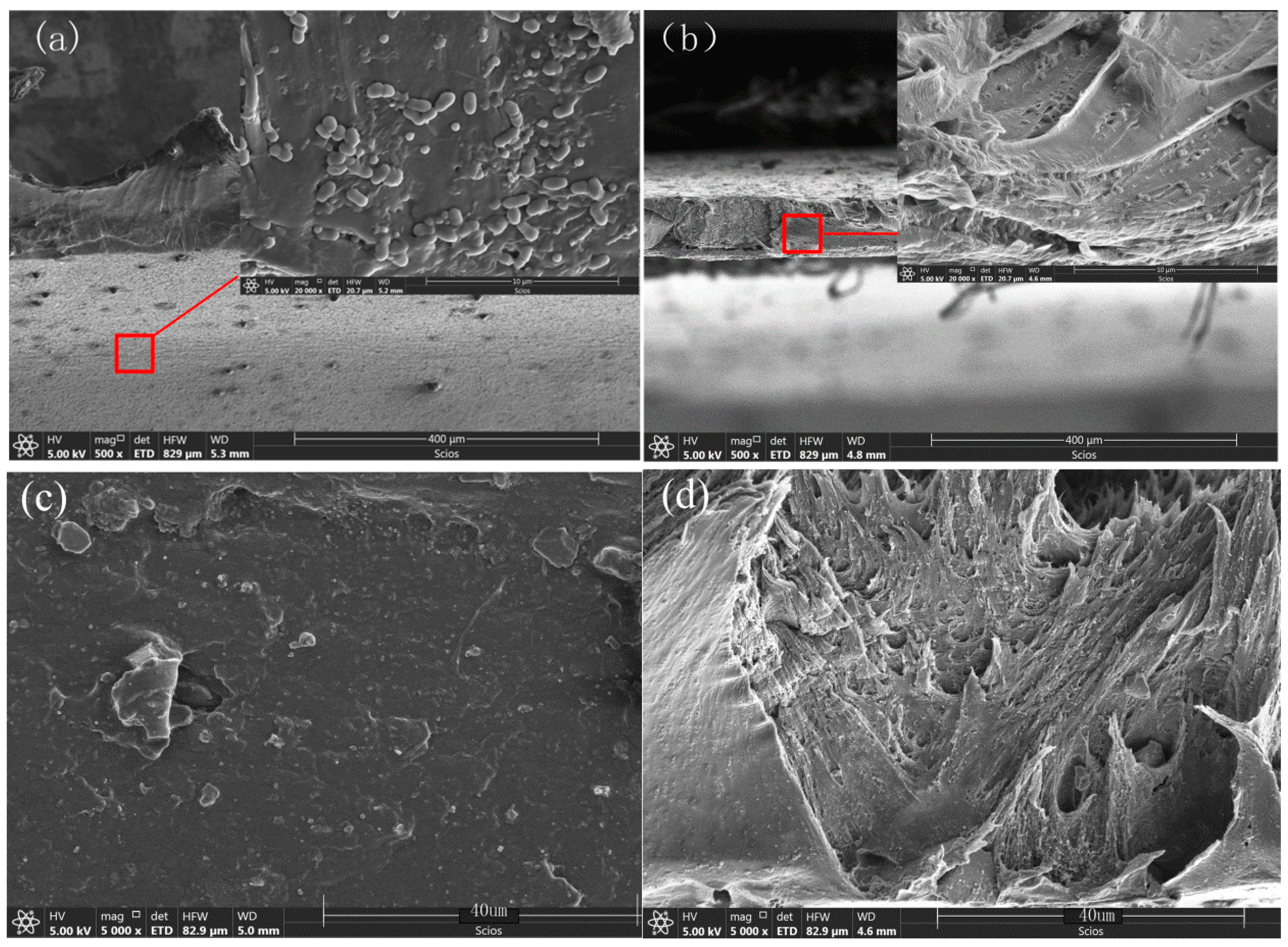
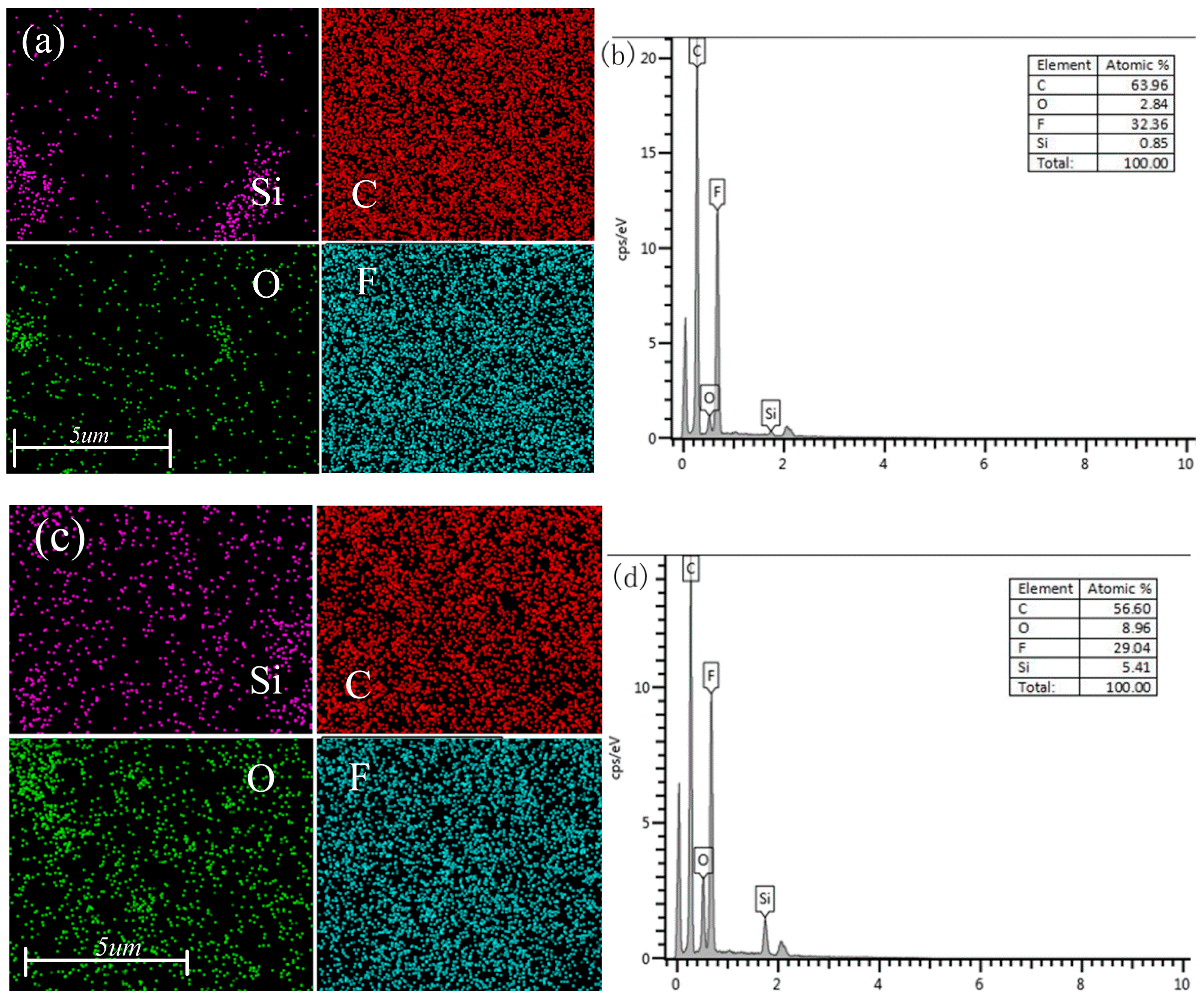
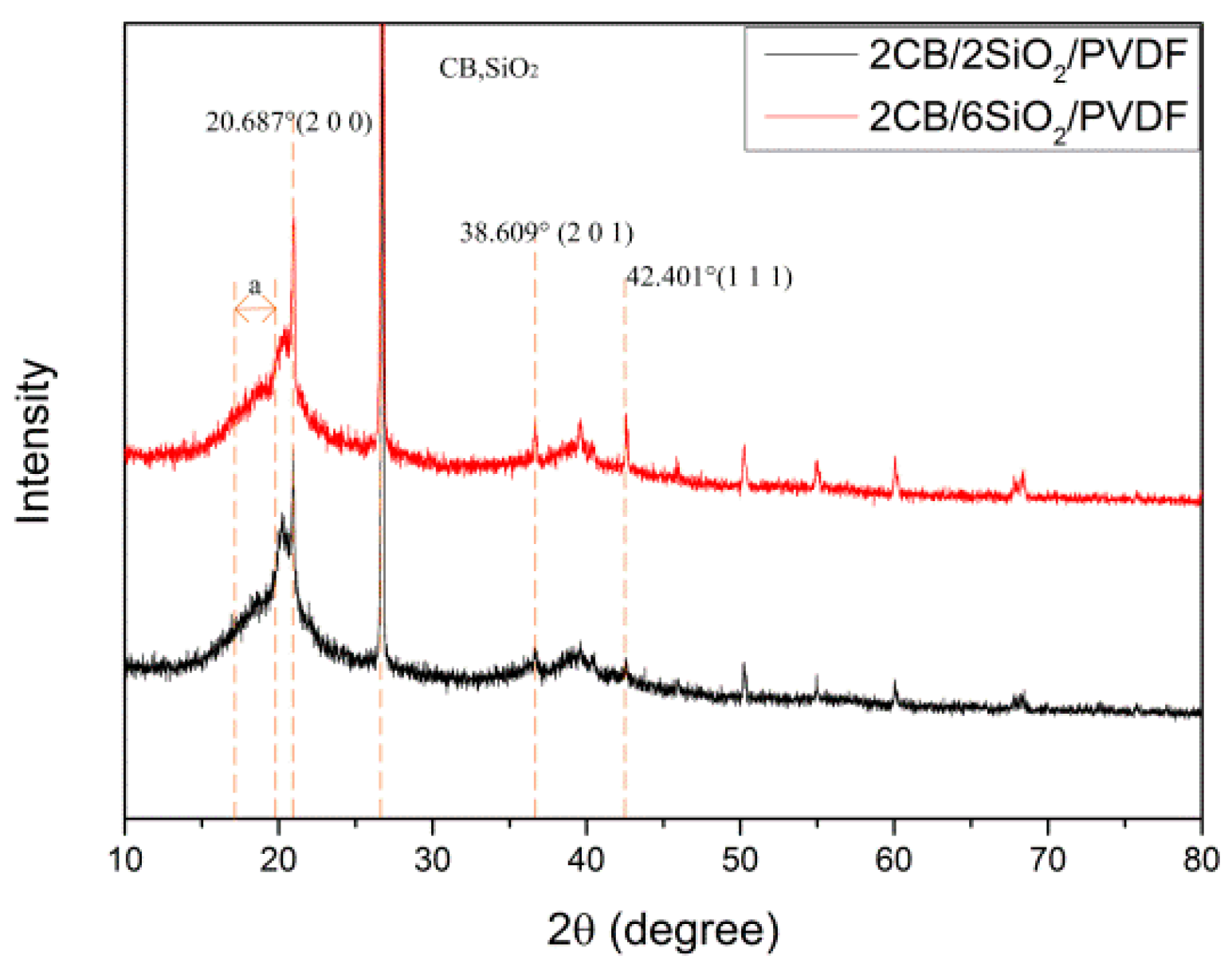

| SiO2 Content (wt.%) | Unnotched Stress (MPa) [20] | 30° Stress (MPa) [20] | 60° Stress (MPa) | 120° Stress (MPa) |
|---|---|---|---|---|
| 0 wt.% | 28.594 ± 1.805 | 21.352 ± 1.782 | 23.009 ± 2.148 | 23.406 ± 1.602 |
| 2 wt.% | 29.598 ± 1.796 | 22.324 ± 1.224 | 23.881 ± 1.574 | 24.671 ± 1.439 |
| 4 wt.% | 30.147 ± 1.897 | 22.648 ± 1.935 | 26.382 ± 2.666 | 28.385 ± 1.529 |
| 6 wt.% | 35.872 ± 2.038 | 25.248 ± 1.731 | 30.831 ± 1.401 | 29.718 ± 1.814 |
| 8 wt.% | 27.828 ± 2.259 | 21.056 ± 1.679 | 25.404 ± 2.273 | 27.451 ± 1.671 |
| CB Content (wt.%) | Tensile Strength (MPa) | σ-Comparison (%) | Strain (-) | ε-Comparison (%) |
|---|---|---|---|---|
| 0 wt.% | 28.594 ± 1.805 | 100 | 0.073 ± 0.007 | 100 |
| 0.5 wt.% | 34.923 ± 2.319 | 122.15 | 0.178 ± 0.009 | 243.8356 |
| 1 wt.% | 36.116 ± 2.843 | 126.32 | 0.269 ± 0.014 | 368.4932 |
| 2 wt.% | 39.960 ± 1.662 | 139.76 | 0.400 ± 0.004 | 547.9452 |
| 4 wt.% | 36.703 ± 1.494 | 128.37 | 0.104 ± 0.010 | 142.4658 |
| 6 wt.% | 34.845 ± 1.812 | 121.87 | 0.071 ± 0.003 | 97.26027 |
| Sample | PVDF (wt.%) | SiO2 (wt.%) | CB (wt.%) | Tensile Strength (MPa) |
|---|---|---|---|---|
| 0.5CB/2SiO2/PVDF | 97.5 | 2 | 0.5 | 32.81 |
| 1CB/2SiO2/PVDF | 97 | 2 | 1 | 34.99 |
| 2CB/2SiO2/PVDF | 96 | 2 | 2 | 37.89 |
| 4CB/2SiO2/PVDF | 94 | 2 | 4 | 37.77 |
| 6CB/2SiO2/PVDF | 92 | 2 | 6 | 35.27 |
| 0.5CB/4SiO2/PVDF | 95.5 | 4 | 0.5 | 40.08 |
| 1CB/4SiO2/PVDF | 95 | 4 | 1 | 44.76 |
| 2CB/4SiO2/PVDF | 94 | 4 | 2 | 32.04 |
| 4CB/4SiO2/PVDF | 92 | 4 | 4 | 25.30 |
| 6CB/4SiO2/PVDF | 90 | 4 | 6 | 25.15 |
| 0.5CB/6SiO2/PVDF | 93.5 | 6 | 0.5 | 25.73 |
| 1CB/6SiO2/PVDF | 93 | 6 | 1 | 32.13 |
| 2CB/6SiO2/PVDF | 92 | 6 | 2 | 27.63 |
© 2020 by the authors. Licensee MDPI, Basel, Switzerland. This article is an open access article distributed under the terms and conditions of the Creative Commons Attribution (CC BY) license (http://creativecommons.org/licenses/by/4.0/).
Share and Cite
Kong, F.; Chang, M.; Wang, Z. Comprehensive Analysis of Mechanical Properties of CB/SiO2/PVDF Composites. Polymers 2020, 12, 146. https://doi.org/10.3390/polym12010146
Kong F, Chang M, Wang Z. Comprehensive Analysis of Mechanical Properties of CB/SiO2/PVDF Composites. Polymers. 2020; 12(1):146. https://doi.org/10.3390/polym12010146
Chicago/Turabian StyleKong, Fangyun, Mengzhou Chang, and Zhenqing Wang. 2020. "Comprehensive Analysis of Mechanical Properties of CB/SiO2/PVDF Composites" Polymers 12, no. 1: 146. https://doi.org/10.3390/polym12010146
APA StyleKong, F., Chang, M., & Wang, Z. (2020). Comprehensive Analysis of Mechanical Properties of CB/SiO2/PVDF Composites. Polymers, 12(1), 146. https://doi.org/10.3390/polym12010146



